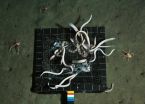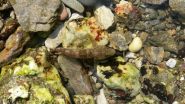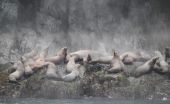New study shows the importance of jellyfish falls to deep-sea ecosystem
2014-10-15
(Press-News.org) This week, researchers from University of Hawai'i, Norway, and the UK have shown with innovative experiments that a rise in jellyfish blooms near the ocean's surface may lead to jellyfish falls that are rapidly consumed by voracious deep-sea scavengers. Previous anecdotal studies suggested that deep-sea animals might avoid dead jellyfish, causing dead jellyfish from blooms to accumulate and undergo slow degradation by microbes, depleting oxygen at the seafloor and depriving fish and invertebrate scavengers, including commercially exploited species, of food.
Globally there are huge numbers of jellyfish in the oceans. In some parts of the ocean, jellyfish "blooms" are increasing apparently due to nutrient enrichment and climate change caused by human activities. In recent years, studies have suggested that when jellyfish blooms die-off, massive quantities of jellyfish sink out of surface waters and can deposit as "jelly-lakes" at the seafloor, choking seafloor habitats of oxygen and reducing biodiversity. This latest research shows that the accumulation of dead jellyfish lakes may be unusual, with jellyfish carcasses normally being rapidly consumed by a host of typical deep-sea scavengers such as hagfish and crabs.
"We just had a hunch that dead jellyfish were important to deep-sea ecosystems in some way, even though they are made up largely of water. We therefore decided to film what the fate of jellyfish carcasses were at the seafloor so we deployed deep-sea lander systems with jellyfish bait. When we later retrieved the landers and found no jellyfish attached to the bait plates we were pleasantly surprised. However, our surprise jumped to another level when we looked at the camera images and saw just how fast the jellyfish baits were consumed and the shear number of scavengers that were consuming the baits. It just blew our minds." lead author Andrew K. Sweetman said. Sweetman is a chief senior scientist and research coordinator for deep-sea ecosystem research at the International Research Institute of Stavanger in Norway.
Published October 15 in the prestigious journal Proceedings of the Royal Society: Biological Sciences, the research looked at the response by scavengers to jellyfish and fish baits in the deep-sea along the Norwegian margin. The researchers found that jellyfish and fish baits were consumed equally fast and attracted similar densities of a diversity of scavengers.
"The speed of the jellyfish scavenging was totally unexpected because earlier, previous observations seemed to suggest that jellyfish carcasses would just rot very slowly at the seafloor. It was also really interesting that the hagfish targeted the most energy-rich parts of the jellyfish, burrowing into the jellyfish carcasses to eat the gonads!" said Craig R. Smith, co-author, designer of the deep-see camera-lander systems used in the study, and a Professor of Oceanography and Pew Fellow in Marine Conservation at the University of Hawai'i at Mānoa, USA.
The study further revealed that the role of jellyfish material could be seriously underestimated in global carbon budgets in the ocean, because jellyfish were removed so quickly that they fail to accumulate at the seafloor, causing scientist to overlook their role in deep-sea food webs.
"Our work shows that previous assessments of the ocean carbon cycle may have missed an important component. Until we saw these photos we thought that the massive amount of jellyfish material was deposited on the seafloor and was essentially taken out of the system – removing carbon rapidly. Our results show that much of this carbon could, in fact, make it into deep-sea food webs, fueling these systems. This is especially important when other food sources to deep-sea ecosystems may be decreasing as our oceans warm" said co-author Daniel Jones, a scientist at the National Oceanography Center in Southampton UK.
Ultimately, this new research reveals that jellyfish blooms could provide far-reaching, potentially important, food supplements to normal deep-sea food webs, rather than having purely negative impacts on fisheries and marine ecosystem function.
INFORMATION:
Link to video and interview (more information below): http://bit.ly/ZYsSNS
BROLL (45 seconds followed by soundbites):
Video of jellyfish being eaten by ocean scavengers
SOUNDBITES:
Craig Smith - Oceanography professor, University of Hawaiʻi at Mānoa (11 seconds)
"And this is real, actually quite important. As the climate warms, as humans change the climate of the earth, and as they put nutrients in the ocean, there's an increase in the abundance of jellyfish."
Smith (14 seconds)
"It may mean that these changes that are occurring in the ocean where jellyfish are becoming more abundant are not as significant, not as bad as we thought they might be. The ocean may be more able to adjust to these changes than we expected."
Smith (13 seconds)
"We've only been able to do these experiments in one location. The scavengers that come are typical of the deep sea but it would be nice to replicate or repeat these experiments in other parts of the ocean to show that the scavenging processes are similar."
Sweetman AK, Smith CR, Dale T, Jones DOB. 2014. Rapid scavenging of jellyfish carcasses reveals the importance of gelatinous material to deep-sea food webs. Proceedings of the Royal Society B 281: 20142210.
http://dx.doi.org/10.1098/rspb.2014.2210
The School of Ocean and Earth Science and Technology at the University of Hawaii at Manoa was established by the Board of Regents of the University of Hawai'i in 1988 in recognition of the need to realign and further strengthen the excellent education and research resources available within the University. SOEST brings together four academic departments, three research institutes, several federal cooperative programs, and support facilities of the highest quality in the nation to meet challenges in the ocean, earth and planetary sciences and technologies.
[Attachments] See images for this press release:

ELSE PRESS RELEASES FROM THIS DATE:
2014-10-15
PROVIDENCE, R.I. [Brown University] — Imagine that a time machine has transported you to the Australian outback 100,000 years ago. As you emerge, you see a huge kangaroo with a round rabbit-like face foraging in a tall bush nearby. The animal's surprising size makes you gasp aloud but when it hears you, becoming equally unnerved, it doesn't hop or lumber away on all fours and tail like every kangaroo you've seen in the present. It walks on its feet. One at a time. Like you.
In a new paper in the journal PLoS ONE, a team of researchers led by Christine Janis, professor ...
2014-10-15
Now extinct giant kangaroos most likely could not hop and used a more rigid body posture to move their hindlimbs one at a time, according to a study published October 15, 2014 in the open-access journal PLOS ONE by Christine Janis from Brown University and colleagues.
The "short-faced," large-bodied sthenurine kangaroos–a now extinct relative to modern-day kangaroos–first appeared in the middle Miocene and became extinct in the late Pleistocene. The largest of these kangaroos had an estimated body mass of 240 kg, almost three times the size of the largest ...
2014-10-15
Turning the street lights off decreased the number of grounded fledglings, according to a study published October 15, 2014 in the open-access journal PLOS ONE by Airam Rodríguez and colleagues from Phillip Island Nature Parks, in Victoria, Australia, and Estación Biológica de Doñana, in Spain.
Thousands of birds are attracted to lights–sometimes referred to as light-pollution–every year worldwide during their first flights from their nests to the open ocean, a phenomenon called 'fallout.' Short-tailed shearwater breeding on the coast of ...
2014-10-15
People who risk their lives to save strangers may do so without deliberation, according to an analysis of statements from more than 50 recognized civilian heroes, conducted by David Rand from Yale University and colleagues published October 15, 2014 in the open access journal PLOS ONE.
Scientists studying human cooperation recruited hundreds of participants to rate 51 statements made during published interviews by recipients of the Carnegie Hero Medal, given to civilians who risk their lives to save strangers. Study participants as well as a computer text analysis algorithm ...
2014-10-15
Research from the University of Exeter has revealed that the rock goby (Gobius paganellus), an unassuming little fish commonly found in rock pools around Britain, southern Europe, and North Africa, is a master of camouflage and can rapidly change colour to conceal itself against its background.
Whether hiding from predators or from families hunting in rock pools, the rock goby can change both its colour and brightness to match its background in just one minute.
Dr Martin Stevens from the Centre for Ecology and Conservation at the University of Exeter's Penryn Campus ...
2014-10-15
An investigation into how patient outcomes are assessed in clinical trials has revealed a worrying lack of consistency, raising concerns about funding being wasted on the acquisition of poor quality data.
Information collected through clinical trials plays a crucial role in improving the standard of patient care. Patient Reported Outcomes (PROs) inform our understanding of how certain treatments and interventions work by evaluating their effectiveness, and any potential side effects, from the patient perspective.
Patients in trials are commonly invited to fill in questionnaires ...
2014-10-15
NEWPORT, Ore. – Pacific sleeper sharks, a large, slow-moving species thought of as primarily a scavenger or predator of fish, may be preying on something a bit larger – protected Steller sea lions in the Gulf of Alaska.
A new study found the first indirect evidence that this cold-blooded shark that can grow to a length of more than 20 feet – longer than a great white shark – may be an opportunistic predator of juvenile Steller sea lions.
Results of the study have just been published in the journal Fishery Bulletin. The findings are important, ...
2014-10-15
Astronomers using the National Science Foundation's Green Bank Telescope (GBT) in West Virginia, along with data from other large radio telescopes, have discovered that our nearest galactic neighbors, the dwarf spheroidal galaxies, are devoid of star-forming gas, and that our Milky Way Galaxy is to blame.
These new radio observations, which are the highest sensitivity of their kind ever undertaken, reveal that within a well-defined boundary around our Galaxy, dwarf galaxies are completely devoid of hydrogen gas; beyond this point, dwarf galaxies are teeming with star-forming ...
2014-10-15
"If you have a coin and flip it just once, what does that tell you about the odds of heads versus tails?" asks Heather Knutson, assistant professor of planetary science at Caltech. "It tells you almost nothing. It's the same with planetary systems," she says.
For as long as astronomers have been looking to the skies, we have had just one planetary system—our own—to study in depth. That means we have only gotten to know a handful of possible outcomes of the planet formation process, and we cannot say much about whether the features observed in our solar system ...
2014-10-15
For those most severely affected, treating epilepsy means drilling through the skull deep into the brain to destroy the small area where the seizures originate – invasive, dangerous and with a long recovery period.
Five years ago, a team of Vanderbilt engineers wondered: Is it possible to address epileptic seizures in a less invasive way? They decided it would be possible. Because the area of the brain involved is the hippocampus, which is located at the bottom of the brain, they could develop a robotic device that pokes through the cheek and enters the brain from ...
LAST 30 PRESS RELEASES:
[Press-News.org] New study shows the importance of jellyfish falls to deep-sea ecosystem






